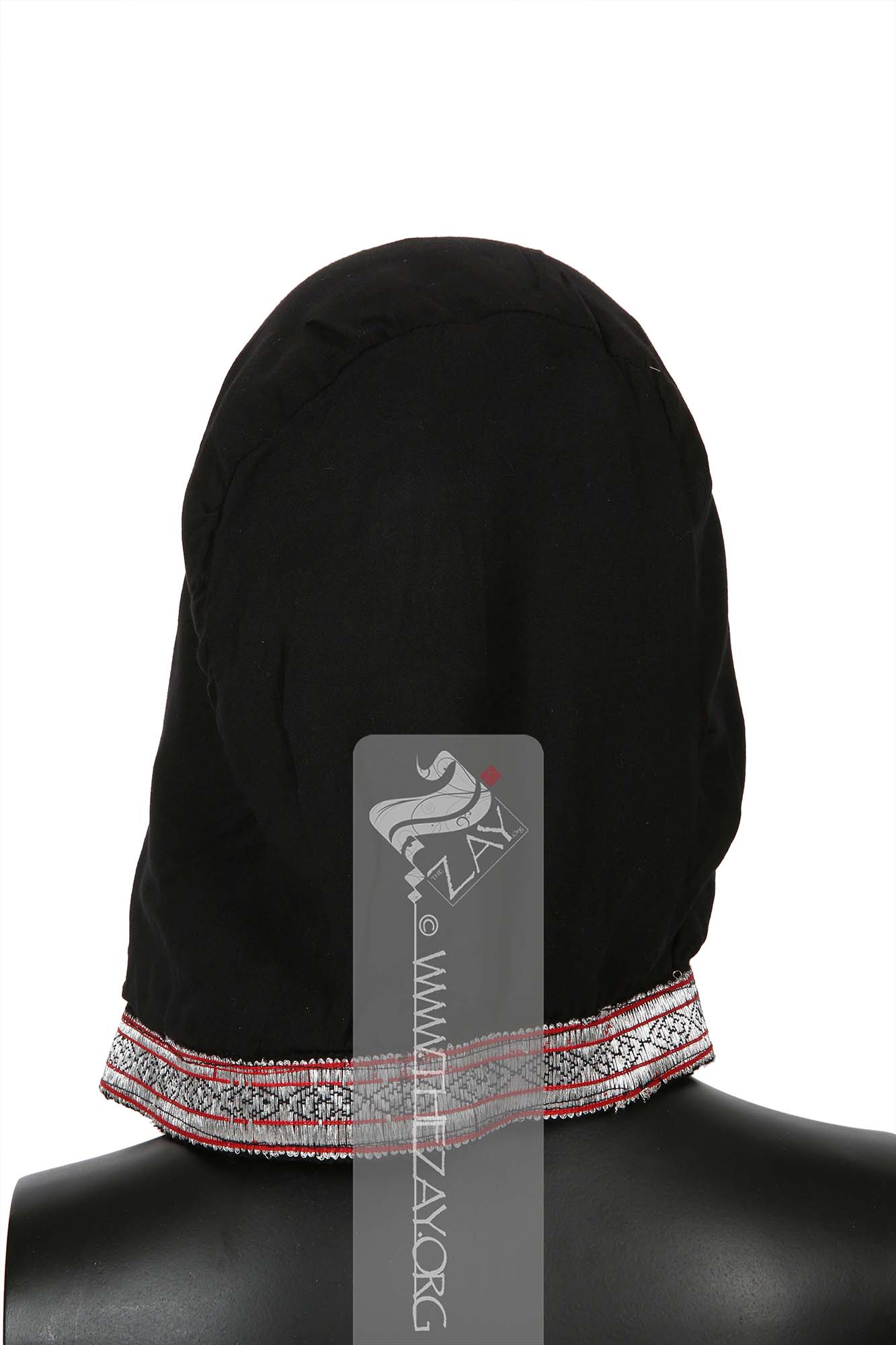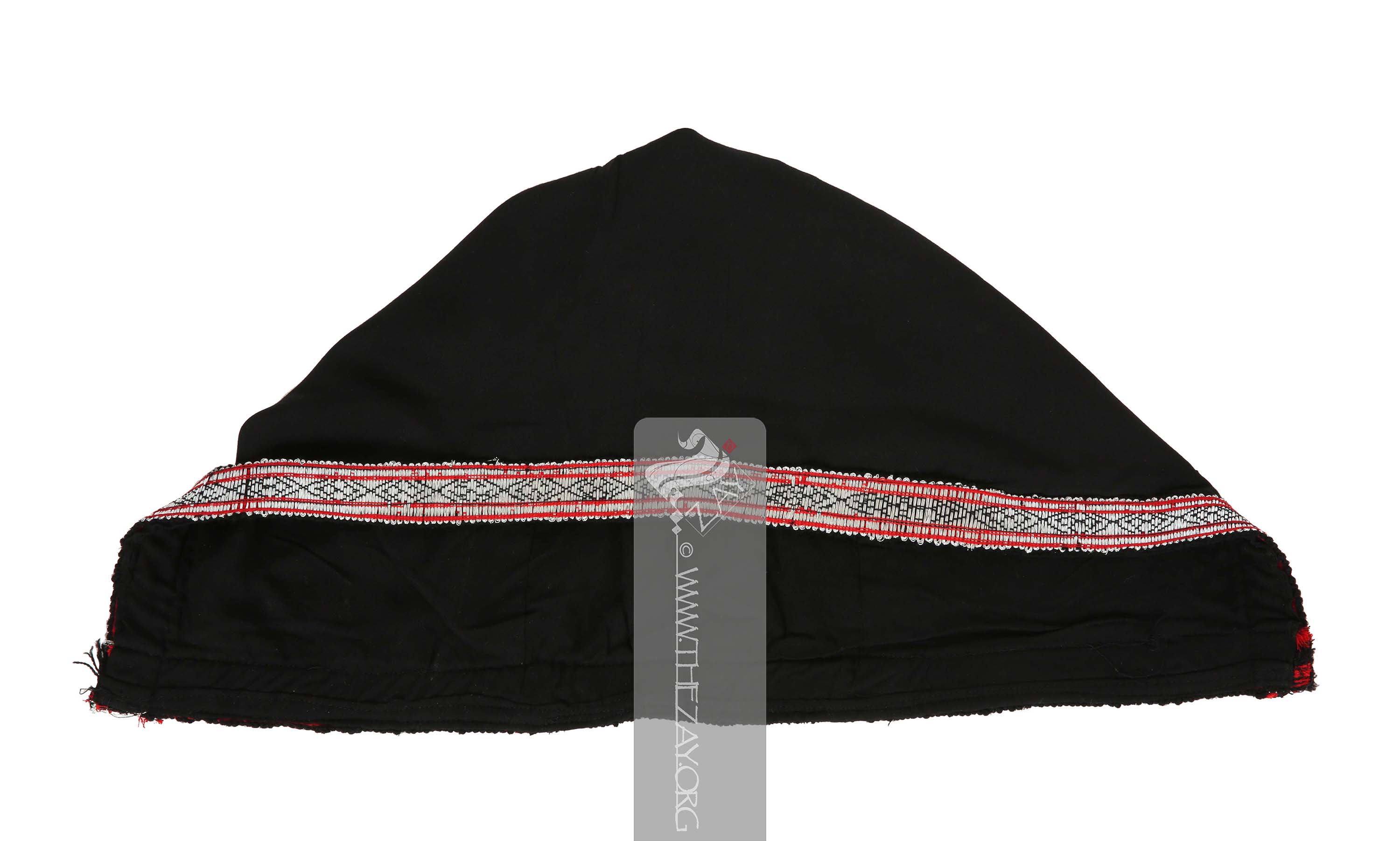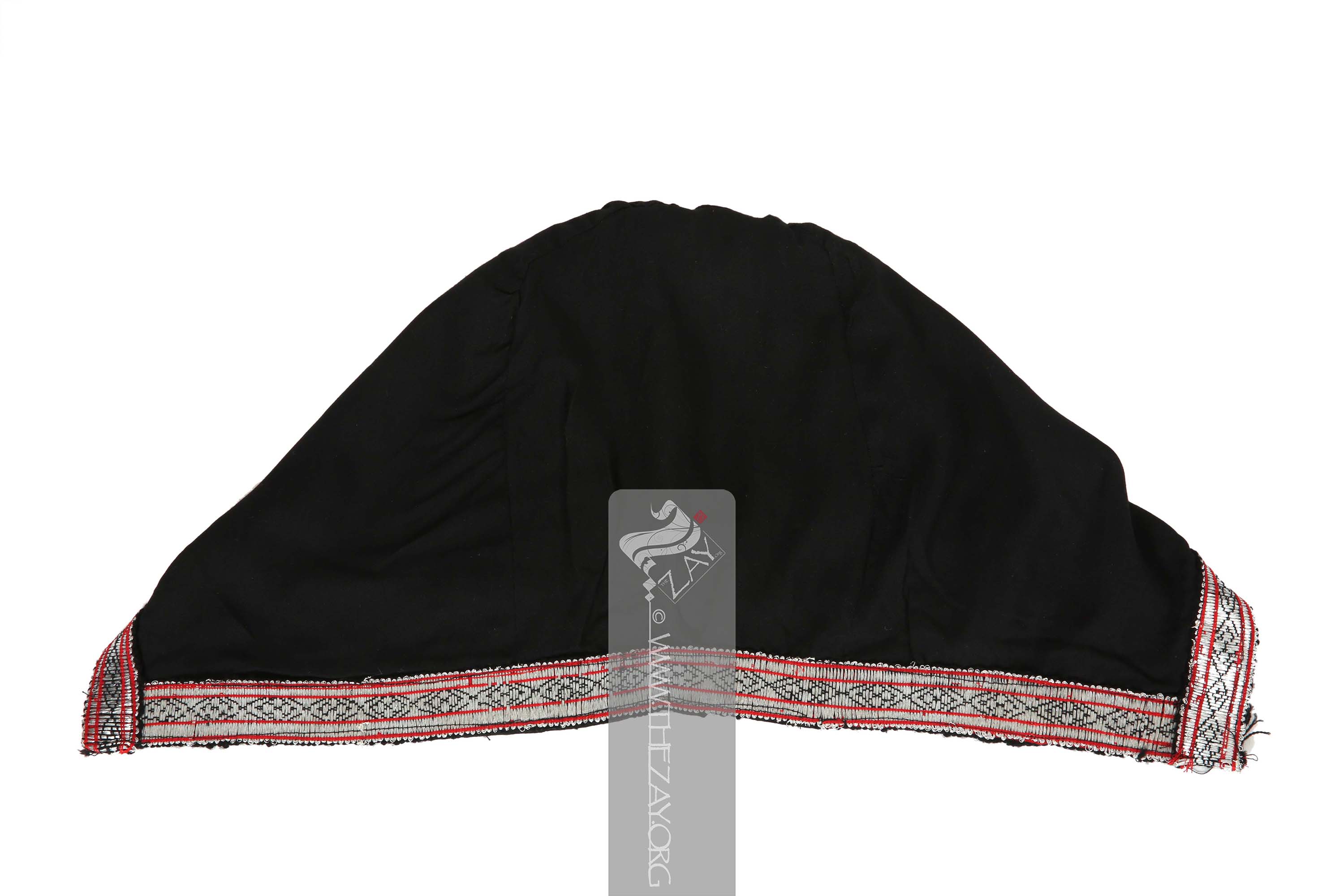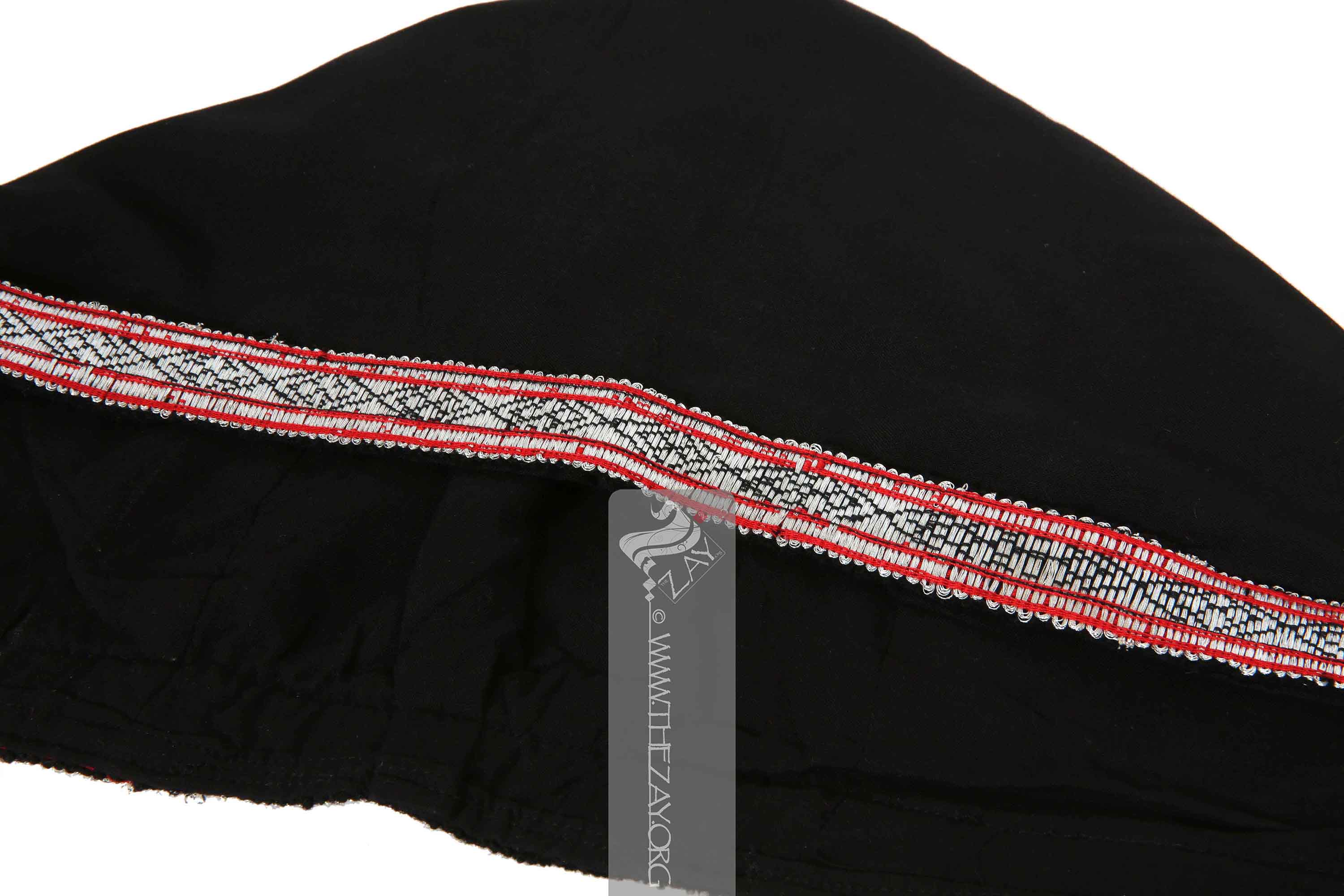Object NoteThis piece (
quba
Qub’a / Qūba’a: (Pl. 'aqbā'a), the part of the clothing that covers the head, a hat and a cap.’ah) is one part of a five-part ensemble including: dress (
thawb_al_sawn
Thawb_al_ṣawn: (Arabic: ṣāna: maintain and protect), colloquially refers to a dress worn by Bani Malik tribe, Saudi Arabia. It’s made of plain cotton, recently of satin, and has the shape of a narrow rectangle.) (
ZI2021.500946.1 KSA), undergarment (
sirwal
Sirwāl: (Farsi: shalvār; Synonym: Salwar, Ṣarwāl, sharwāl, salbāl, khalag), pair of trousers with tapering ankles and fastened with a draw string. Believed to have originated in Central Asia it has spread since in the Indian subcontinent between c. 1st – 3rd century BCE and the Middle East from c. 12th century. ) (
ZI2021.500946.1a KSA), headband (‘usabah) (
ZI2021.500946.1c KSA), and flask (
ZI2021.500946.1d KSA). This outfit was purchased together with two other full outfits, Harb tribe
thawb
Thawb: (Arabic: thawb, Pl. Athwāb/thībān), can be pronounced thobe
Thobe: (Arabic: thawb, Pl. Athwāb/thībān), can be pronounced thawb or tobe
Tobe: (Arabic: thawb, Pl. Athwāb/thībān), can be pronounced thawb or thobe based on locale. The standard Arabic word for ‘fabric’ or ‘garment’. It can refer to a qamīs-like tunic worn by men and women in the Arabian Peninsula, Iraq, the southern and south-western ports and islands of Iran, and some countries in East and West Africa. More specifically, it can refer to the square-shaped Bedouin overgarment worn by women. based on locale. The standard Arabic word for ‘fabric’ or ‘garment’. It can also refer to a qamīs-like tunic worn by men and women in the Arabian Peninsula, Iraq, the southern and south-western ports and islands of Iran, and some countries in East and West Africa. More specifically, it can refer to the square-shaped Bedouin overgarment worn by women. or tobe
Tobe: (Arabic: thawb, Pl. Athwāb/thībān), can be pronounced thawb or thobe based on locale. The standard Arabic word for ‘fabric’ or ‘garment’. It can refer to a qamīs-like tunic worn by men and women in the Arabian Peninsula, Iraq, the southern and south-western ports and islands of Iran, and some countries in East and West Africa. More specifically, it can refer to the square-shaped Bedouin overgarment worn by women. based on locale. The standard Arabic word for ‘fabric’ or ‘garment’. It can also refer to a qamīs-like tunic worn by men and women in the Arabian Peninsula, Iraq, the southern and south-western ports and islands of Iran, and some countries in East and West Africa. More specifically, it can refer to the square-shaped Bedouin overgarment worn by women in the Arabian Gulf region. (ZI2021.500946.2 KSA) and Hijazi bridal
thawb
Thawb: (Arabic: thawb, Pl. Athwāb/thībān), can be pronounced thobe
Thobe: (Arabic: thawb, Pl. Athwāb/thībān), can be pronounced thawb or tobe
Tobe: (Arabic: thawb, Pl. Athwāb/thībān), can be pronounced thawb or thobe based on locale. The standard Arabic word for ‘fabric’ or ‘garment’. It can refer to a qamīs-like tunic worn by men and women in the Arabian Peninsula, Iraq, the southern and south-western ports and islands of Iran, and some countries in East and West Africa. More specifically, it can refer to the square-shaped Bedouin overgarment worn by women. based on locale. The standard Arabic word for ‘fabric’ or ‘garment’. It can also refer to a qamīs-like tunic worn by men and women in the Arabian Peninsula, Iraq, the southern and south-western ports and islands of Iran, and some countries in East and West Africa. More specifically, it can refer to the square-shaped Bedouin overgarment worn by women. or tobe
Tobe: (Arabic: thawb, Pl. Athwāb/thībān), can be pronounced thawb or thobe based on locale. The standard Arabic word for ‘fabric’ or ‘garment’. It can refer to a qamīs-like tunic worn by men and women in the Arabian Peninsula, Iraq, the southern and south-western ports and islands of Iran, and some countries in East and West Africa. More specifically, it can refer to the square-shaped Bedouin overgarment worn by women. based on locale. The standard Arabic word for ‘fabric’ or ‘garment’. It can also refer to a qamīs-like tunic worn by men and women in the Arabian Peninsula, Iraq, the southern and south-western ports and islands of Iran, and some countries in East and West Africa. More specifically, it can refer to the square-shaped Bedouin overgarment worn by women in the Arabian Gulf region. (ZI2021.500946.3 KSA).
Object History Once our Digital Archive launched in 2019, people began to reach out to donate, sell, or point out interesting outfits and body adornments to The
Zay
Zay: (Arabic: costume, Pl. azyaā’), a set of clothes in a style typical of a particular country or historical period. team. When the webinar (Traditional Costumes and Heritage of Saudi Arabia) aired in July of 2021, Mr. Zakaria Ahmed, silver and antique dealer from Yemen and close supporter of The
Zay
Zay: (Arabic: costume, Pl. azyaā’), a set of clothes in a style typical of a particular country or historical period. Initiative’s work, managed to source three interesting and complete outfits through his personal connections throughout the region. Though not the highest of quality,
Dr. Reem Tariq
Ṭariq: (Arabic; Synonym: tulle_bi_talli
Tūlle_bi_tallī: (French: Tulle – a city in France where fine material for veil was first made; Turkish: tel – wire; Synonym: tariq; talli; badla; khus_dozi ), series of small metal knots made on a woven net ground as embellishment. The term is commonly used in the North African Arab region specifically in Egypt.
; talli; badla; khus_dozi ), series of small metal knots made on a woven net ground as embellishment. The term is commonly used in the Levant Arab region specifically in Lebanon.
El Mutwalli
Dr. Reem Tariq
Ṭariq: (Arabic; Synonym: tulle_bi_talli
Tūlle_bi_tallī: (French: Tulle – a city in France where fine material for veil was first made; Turkish: tel – wire; Synonym: tariq; talli; badla; khus_dozi ), series of small metal knots made on a woven net ground as embellishment. The term is commonly used in the North African Arab region specifically in Egypt.
; talli; badla; khus_dozi ), series of small metal knots made on a woven net ground as embellishment. The term is commonly used in the Levant Arab region specifically in Lebanon.
el Mutwallī: Founder (CEO) of the Zay
Zay: (Arabic: costume, Pl. azyaā’), a set of clothes in a style typical of a particular country or historical period. Initiative, a public figure, speaker and author. An expert curator and consultant in Islamic art and architecture, interior design, historic costume, and UAE heritage. was very quick to acquire and add them to augment the Saudi section of The
Zay
Zay: (Arabic: costume, Pl. azyaā’), a set of clothes in a style typical of a particular country or historical period. Collection.
Object Features The headdress (
quba
Qub’a / Qūba’a: (Pl. 'aqbā'a), the part of the clothing that covers the head, a hat and a cap.’ah), also known as (
gargush
Gargūsh: (Arabic: Qarqūsh), a hood-shaped coif traditionally worn by women of the Jewish community in Yemen. In this case, the name is a variant of the original Arabic word in the local Yemeni dialect.
), is worn by both Bani Malik tribe women in the Taif region, Saudi Arabia, and by the Harb tribe women. The size and shape vary depending on location, function, age, and the intended wearer’s head.
Basically, a simple hood-shape made of the same black cotton as the accompanying dress (
thawb_al_sawn
Thawb_al_ṣawn: (Arabic: ṣāna: maintain and protect), colloquially refers to a dress worn by Bani Malik tribe, Saudi Arabia. It’s made of plain cotton, recently of satin, and has the shape of a narrow rectangle.). It covers the head and extends to shoulder level. Typically, the
quba
Qub’a / Qūba’a: (Pl. 'aqbā'a), the part of the clothing that covers the head, a hat and a cap.’ah is completely covered with either embroidery and beads or woven strands of (
khurayan
Khurayān: (colloquial Saudi), refers to small, coloured glass beads to decorate face masks or articles of clothing.). However, in this example, only the outer edges are hemmed with a woven silver, red, and black ribbon of geometric shapes, applied by hand.










